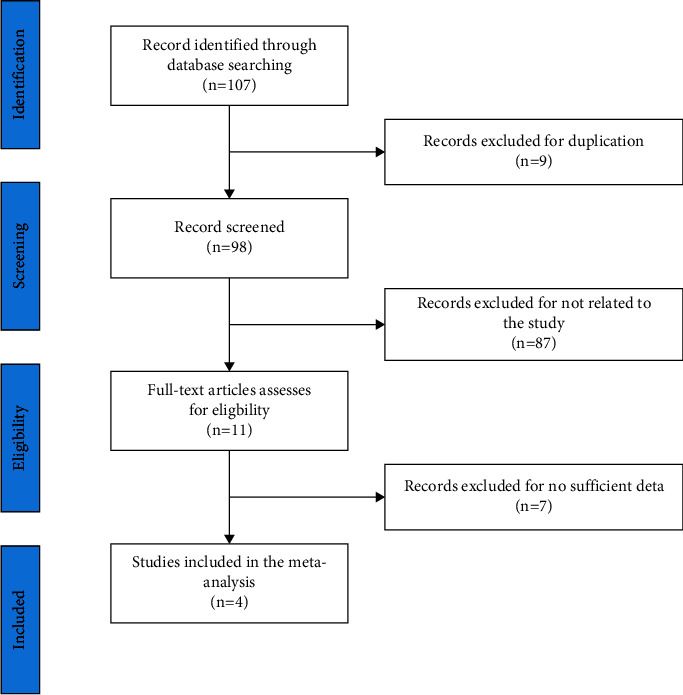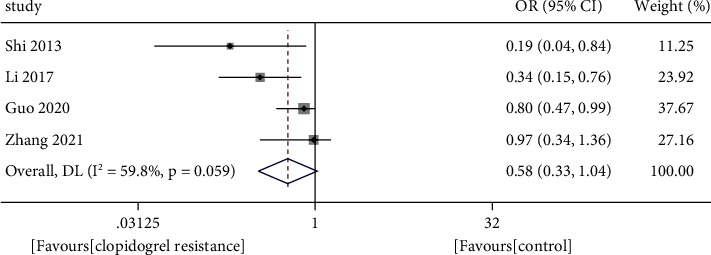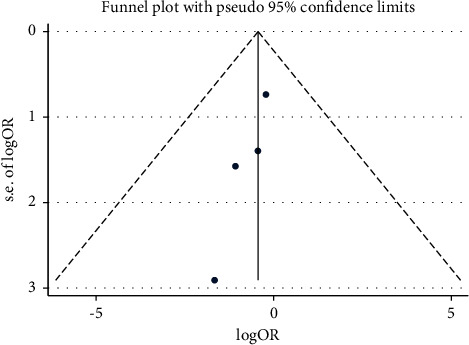Abstract
Objectives
To evaluate the relationship between the plasma miR-223 expression level and clopidogrel resistance in acute coronary syndrome (ACS) patients.
Methods
We performed a search for publications using online databases including PubMed, EMBASE, Cochrane Library, and Chinese Databases (CNKI database, Weipu database, and Wanfang database) from the inception of the databases to June 18, 2023, to identify studies reporting the relationship between the plasma miR-223 level and clopidogrel resistance in ACS patients. Two researchers independently searched and screened to ensure the consistency of the results and assess the quality of the included studies according to the Newcastle-Ottawa scale. A fixed-effects model was used for pooling data with STATA 14.0.
Results
Four articles including 399 Chinese ACS patients were eligible for the meta-analysis. Low plasma miR-223 levels were independently correlated with clopidogrel resistance in Chinese ACS patients (OR 0.58, 95% CI: 0.33–1.04).
Conclusion
Lower plasma miR-223 levels are associated with clopidogrel resistance in Chinese ACS patients, suggesting that miR-223 may be a potential diagnostic biomarker of clopidogrel resistance.
1. Introduction
Inhibition of platelet function by means of dual antiplatelet therapy (DAPT) is the cornerstone of treatment in acute coronary syndrome (ACS). For ACS patients, DAPT with aspirin and clopidogrel is the mainstay of treatment [1–3]. Several clinical trials and basic research studies have suggested that there is wide variability in the antiplatelet response in ACS patients receiving loading doses or a standard regimen of clopidogrel [4–9]. The risk of ischemic events is still high in ACS patients, which could be partially contributed by “clopidogrel resistance.” Clopidogrel resistance is usually defined as ADP-induced platelet aggregation function (PAF) exceeding 208 units, which often leads to new onset and recurrence of ischemic events [4]. Many factors, including expression of P2Y12 receptors on the platelet, pharmaceutical metabolic enzyme activity in the liver, drug-drug interaction, and demographic characteristics, are important risk factors for clopidogrel resistance [10].
MicroRNA is a small nonencoding RNA molecule that adjusts the functionality of multiple specific mRNA by adjusting translation and degradation of mRNA. It is estimated that more than 40% of the plasma microRNAs are derived from platelets [11]. Previous studies showed that microRNA-223 (miR-223) downregulates the expression of P2Y12 receptors on the platelet, which is the key protein for clopidogrel binding and PAF [12]. Moreover, small clinical samples suggest that the relationship between the plasma miR-223 level and clopidogrel resistance remains controversial [4–9]. Therefore, we explored the relationship between the plasma miR-223 level and clopidogrel resistance in ACS patients through a systematic review and meta-analysis.
2. Materials and Methods
2.1. Search Strategy
We performed a comprehensive search for publications using online English databases (including PubMed, EMBASE, and Cochrane Library) and Chinese database (including CNKI database, Weipu database, and Wanfang database) from the inception of the databases to Jun 18, 2023. The literature retrieval strategy was created by one author and then approved by the other authors, using keywords of “miR-223 OR microRNA-223 OR miRNA OR microRNA” AND “clopidogrel.” Moreover, all included studies were screened manually to identify further qualifying studies.
2.2. Study Inclusion and Exclusion Criteria
The following articles were included in our meta-analysis: (i) all adult participants received a diagnosis of ACS and received a loading dose of 300 mg aspirin plus 300 mg clopidogrel for at least 24 h, or 100 mg aspirin plus 75 mg clopidogrel for at least 5 days, to reach a stable drug concentration, (ii) all participants were separated into cohorts based on plasma miR-223 levels, and (iii) the odds ratio (OR) and 95% confidence intervals (CI) were available. Studies were excluded if they met the following criteria: (i) case reports, reviews, conference abstracts, letters, and animal studies, (ii) duplicated studies, and (iii) insufficient data required.
2.3. Data Extraction and Quality Assessment
All studies and data were independently reviewed and extracted by two authors (H.C. and M.Y.). A third author (J.Y.) was consulted for resolution of any conflicts. The Preferred Reporting Items for Systematic Reviews and Meta-Analyses (PRISMA) statement was followed for this systematic review [13]. Relevant data included authors, publication year, research location, recruitment duration, sample size, detection methods of the plasma miR-223 level, and PAF. There was no preregistration for the review. Study quality was evaluated according to the Newcastle-Ottawa Quality Assessment Scale (NOS) [14].
2.4. Statistical Analysis
The relationship between plasma miR-223 levels and clopidogrel resistance was examined by pooling the OR and 95% CI. A funnel plot and Egger's linear regression test to examine the publication bias. Statistical analyses were conducted in STATA 14.0 (StataCorp, TX, USA).
3. Results
3.1. Results of Literature Search and Characteristics of the Studies Included
The study screen flowchart is summarized in Figure 1. We found 107 relevant articles in the initial search. After reviewing the titles and abstracts, 98 of them were deemed ineligible since they were duplicated articles, review articles, letters, or animal studies, etc. Then, we screened the remaining 11 studies for eligibility, of which 7 were further excluded for insufficient data. Finally, 4 articles including 399 patients were included in the meta-analysis.
Figure 1.

Flowchart showing the study selection process.
All studies were conducted in China. Plasma miR-223 levels were examined via quantitative real-time polymerase chain reaction (qRT-PCR) in all studies, and clopidogrel and antiplatelet responsiveness were evaluated according to the calculation of the percentage of platelet aggregation. The NOS assessment score of the 4 included studies varies from 7 to 9, indicating that all 4 studies have high quality based on the quality assessment. More detailed information is presented in Table 1.
Table 1.
Characteristics of the studies included.
| Study | Region | Recruitment time | Study type | Disease type | Sample size | Experimental sample | Analysis method | Platelet function test | miRNA detection method | Quality score |
|---|---|---|---|---|---|---|---|---|---|---|
| Shi et al. 2013 | China | NS | Cohort study | NSTE-ACS | 33 | Plasma | Univariate/multivariate analysis | LTA | qRT-PCR | 8 |
| Li et al. 2017 | China | 2013-2014 | Cohort study | NSTE-ACS | 39 | Plasma | Univariate/multivariate analysis | LTA | qRT-PCR | 8 |
| Guo et al. 2020 | China | 2017-2018 | Cohort study | CHD | 119 | Plasma | Univariate/multivariate analysis | TEG | qRT-PCR | 7 |
| Zhang et al. 2021 | China | 2016-2017 | Cohort study | NSTE-ACS | 208 | Plasma | Univariate/multivariate analysis | Flow cytometer | qRT-PCR | 9 |
NS: not sure; NSTE-ACS: non-st-segment elevation acute coronary syndrome; LTA: light transmittance aggregometry; TEG: thrombelastograph coagulation analyzer; CHD: coronary heart disease.
3.2. Relationship between the Plasma miR-223 Level and Clopidogrel Resistance
Based on pooling analysis, low plasma miR-223 levels were correlated with clopidogrel resistance in ACS patients (OR 0.58, 95% CI: 0.33–1.04, as shown in Figure 2). There was significant heterogeneity across studies (I2 = 59.8%; P=0.059). Evidence of publication bias was observed by the symmetrical funnel plot (shown in Figure 3) and Egger's linear regression test (P=0.021).
Figure 2.

Forest plots showing odds ratio and 95% confidence intervals of clopidogrel resistance in acute coronary for the lower plasma miR-223 level.
Figure 3.

Funnel plot.
4. Discussion
Clopidogrel resistance is one of the key factors resulting in failure of clopidogrel antiplatelet therapy for ACS patients, and it is time-consuming and unstable to diagnose clopidogrel resistance by PAF [15]. Therefore, it is important to find easily detectable diagnostic biomarkers of clopidogrel resistance.
It is known that miR-223 levels are largely modulated during ACS events [16], and multiple studies have suggested that miR-223 can be exploited as a biomarker for platelet activation and that its levels are associated with antiplatelet treatment and the individual response to it [17–19]. Our meta-analysis shows that plasma miR-223 may be a diagnostic biomarker to predict clopidogrel resistance in patients with ACS. To the best of our knowledge, this is the first meta-analysis which indicated the clinical diagnostic role of miR-223 on clopidogrel resistance in ACS.
The mechanism of the lower plasma miR-223 level indicating clopidogrel resistance could be related to miR-223's regulation of the expression of the platelet P2Y12 receptor. The P2Y12 receptor is the key protein of platelet aggregation, and more expression of the platelet P2Y12 receptor leads to higher PAF. Schubert and Devine suggested that there is a miR-223 binding site in the 3 UTR of P2Y12 mRNA, miR-223 binds to the P2Y12 mRNA, and it reduces the expression of platelet P2Y12 receptor [20]. Recent studies have shown that miR-223 can regulate the expression of platelet P2Y12 receptors via posttranslational regulation, which might explain why lower levels of plasma miR-223 could increase platelet P2Y12 receptors and induce clopidogrel resistance [21]. However, Carino found that switching from a dual antiplatelet therapy including aspirin and clopidogrel to the more potent ticagrelor resulted in a decrease in plasma miR-233 levels, suggesting that the use of ticagrelor also decreased plasma miR-233 expression levels and induced ticagrelor resistance, which needs to be confirmed by further research [22].
There are several limitations to this meta-analysis. First, all studies were conducted in China, so the result may be not generalizable to other races. Second, the result was based on only 399 ACS patients from four articles and should be verified by large sample studies in the future. Third, the relationship between the plasma miR-223 level and the clinical outcome was not evaluated, which should be explored in the future studies. Fourth, the result of publication bias based on Egger's test may be unreliable. Finally, the cut-off value for identifying patients who are low responders to clopidogrel therapy varies.
All in all, our meta-analysis shows that lower plasma miR-223 levels are associated with clopidogrel resistance in Chinese ACS patients and that miR-223 may be a potential diagnostic biomarker of clopidogrel resistance. However, the current evidence level of most studies is relatively low for a small number of samples.
Acknowledgments
JY holds fundings from the National Natural Science Foundation of China (82171295) and Chengdu Science and Technology Bureau (2020-GH02-00057-HZ). ST holds fundings from Science & Technology Department of Sichuan Province (2021YFS0376). YL holds fundings from Chengdu Medical College (CYFY2018ZD01, 2021LHJYZD-01, and CYFY2021YB04).
Contributor Information
Yapeng Lin, Email: linyapengsjnk@163.com.
Jie Yang, Email: yangjie1126@163.com.
Data Availability
The data used to support the findings of this study are available from the corresponding author upon request.
Disclosure
An abstract of this study was presented at the Asia Pacific Stroke Conference 2022 [23].
Conflicts of Interest
The authors declare that they have no conflicts of interest.
Authors' Contributions
JY and YL conceived the study. HC and MY screened the studies and extracted data. HC and MY performed the quality assessment. HC conducted the statistical analysis and wrote the first draft of the manuscript; all the authors read, revised, and approved the final version. The authors Hang Cheng and Min Yang contributed equally to this work.
References
- 1.Yuxue Z., Zhangxin C., Zhuhua D. Guidelines for rapid emergency diagnosis and treatment of acute coronary syndrome. Chinese Journal of Emergency Medicine . 2016;36(3):207–214. [Google Scholar]
- 2.Bhatt D. L., Hulot J. S., Moliterno D. J., Harrington R. A. Antiplatelet and anticoagulation therapy for acute coronary syndromes. Circulation Research . 2014;114(12):1929–1943. doi: 10.1161/circresaha.114.302737. [DOI] [PubMed] [Google Scholar]
- 3.Collet J. P., Thiele H., Barbato E., et al. 2020 ESC Guidelines for the management of acute coronary syndromes in patients presenting without persistent ST-segment elevation. European Heart Journal . 2021;42(14):1289–1367. doi: 10.1093/eurheartj/ehaa575. [DOI] [PubMed] [Google Scholar]
- 4.Chyrchel B., Totoń-Żurańska J., Kruszelnicka O., et al. Association of plasma miR-223 and platelet reactivity in patients with coronary artery disease on dual antiplatelet therapy: a preliminary report. Platelets . 2015;26(6):593–597. doi: 10.3109/09537104.2014.974527. [DOI] [PubMed] [Google Scholar]
- 5.Shi R., Ge L., Zhou X., et al. Decreased platelet miR-223 expression is associated with high on-clopidogrel platelet reactivity. Thrombosis Research . 2013;131(6):508–513. doi: 10.1016/j.thromres.2013.02.015. [DOI] [PubMed] [Google Scholar]
- 6.Peng L., Liu J., Qin L., et al. Interaction between platelet-derived microRNAs and CYP2C19∗2 genotype on clopidogrel antiplatelet responsiveness in patients with ACS. Thrombosis Research . 2017;157:97–102. doi: 10.1016/j.thromres.2017.07.011. [DOI] [PubMed] [Google Scholar]
- 7.Guo Y. M., Lin L., Li H. Z. Platelet microrNA-223 and microrNA-21 predict clopidogrel resistance after percutaneous coronary intervention in patients with coronary heart disease. Journal of Clinical Medicine . 2020;37(1):28–31. [Google Scholar]
- 8.Zhang Y. Y., Guo X. K., Zheng J. Y., et al. Correlation of circulating microrNA-223 levels with platelet response and clinical prognosis in patients with acute coronary syndrome. Tianjin Pharmaceutical . 2022;49(3):285–290. [Google Scholar]
- 9.Zhang Y. Y., Zhou X., Ji W. J., et al. Decreased circulating microRNA-223 level predicts high on-treatment platelet reactivity in patients with troponin-negative non-ST elevation acute coronary syndrome. Journal of Thrombosis and Thrombolysis . 2014;38(1):65–72. doi: 10.1007/s11239-013-1022-9. [DOI] [PubMed] [Google Scholar]
- 10.Hernandez-Suarez D., Rodrigues Botton M., Scott S. A., et al. Pharmacogenetic association study on clopidogrel response in Puerto Rican Hispanics with cardiovascular disease: a novel characterization of a Caribbean population. Pharmacogenomics and Personalized Medicine . 2018;11:95–106. doi: 10.2147/pgpm.s165805. [DOI] [PMC free article] [PubMed] [Google Scholar]
- 11.Sugunaraj J. P., Palaniswamy C., Selvaraj D. R., Chaitanya Arudra S. K., Sukhija R. Clopidogrel resistance. American Journal of Therapeutics . 2010;17(2):210–215. doi: 10.1097/mjt.0b013e3181bdc3e4. [DOI] [PubMed] [Google Scholar]
- 12.Bushati N., Cohen S. M. microRNA functions. Annual Review of Cell and Developmental Biology . 2007;23(1):175–205. doi: 10.1146/annurev.cellbio.23.090506.123406. [DOI] [PubMed] [Google Scholar]
- 13.Liberati A., Altman D. G., Tetzlaff J., et al. The PRISMA statement for reporting systematic reviews and meta-analyses of studies that evaluate healthcare interventions: explanation and elaboration. BMJ . 2009;339(1):p. 2700. doi: 10.1136/bmj.b2700. [DOI] [PMC free article] [PubMed] [Google Scholar]
- 14.Wells G., Shea B., Connell D. O., Peterson J., Tugwell P. The Newcastle-Ottawa Scale (NOS) for assessing the quality if nonrandomized studies in meta-analyses. 2010. https://www.ohri.ca/programs/clinical_epidemiology/oxford.asp .
- 15.Bonello L., Laine M., Baumstarck K., et al. A randomized trial of platelet reactivity monitoring-adjusted clopidogrel therapy versus prasugrel therapy to reduce high on-treatment platelet reactivity. International Journal of Cardiology . 2013;168(4):4244–4248. doi: 10.1016/j.ijcard.2013.07.147. [DOI] [PubMed] [Google Scholar]
- 16.De Rosa S., Fichtlscherer S., Lehmann R., Assmus B., Dimmeler S., Zeiher A. M. Transcoronary concentration gradients of circulating microRNAs. Circulation . 2011;124(18):1936–1944. doi: 10.1161/circulationaha.111.037572. [DOI] [PubMed] [Google Scholar]
- 17.Zhang M. W., Shen Y. J., Shi J., Yu J. G. MiR-223-3p in cardiovascular diseases: a biomarker and potential therapeutic target. Front Cardiovasc Med . 2020;7 doi: 10.3389/fcvm.2020.610561.610561 [DOI] [PMC free article] [PubMed] [Google Scholar]
- 18.Eyileten C., Wicik Z., Keshwani D., et al. Alteration of circulating platelet-related and diabetes-related microRNAs in individuals with type 2 diabetes mellitus: a stepwise hypoglycaemic clamp study. Cardiovascular Diabetology . 2022;21(1):p. 79. doi: 10.1186/s12933-022-01517-5. [DOI] [PMC free article] [PubMed] [Google Scholar]
- 19.Pordzik J., Pisarz K., De Rosa S., et al. The potential role of platelet-related microRNAs in the development of cardiovascular events in high-risk populations, including diabetic patients: a review. Frontiers in Endocrinology . 2018;9:p. 74. doi: 10.3389/fendo.2018.00074. [DOI] [PMC free article] [PubMed] [Google Scholar]
- 20.Schubert P., Devine D. V. Retracted:De novo protein synthesis in mature platelets: a consideration for transfusion medicine. Vox Sanguinis . 2010;99(2):112–122. doi: 10.1111/j.1423-0410.2010.01333.x. [DOI] [PubMed] [Google Scholar]
- 21.Liu Y. L., Hu X. L., Song P. Y., et al. Influence of GAS5/MicroRNA-223-3p/P2Y12 Axis on clopidogrel response in coronary artery disease. Journal of American Heart Association . 2021;10(21) doi: 10.1161/JAHA.121.021129.21129 [DOI] [PMC free article] [PubMed] [Google Scholar]
- 22.Carino A., De Rosa S., Sorrentino S., et al. Modulation of circulating MicroRNAs levels during the switch from clopidogrel to ticagrelor. BioMed Research International . 2016;2016:5. doi: 10.1155/2016/3968206.3968206 [DOI] [PMC free article] [PubMed] [Google Scholar]
- 23.Byung-Woo Y., Jiunn-Tay L., Ku-Chou C., Kazunori T., Jiann-Shing J., Narayanaswamy V. Asia pacific Stroke conference 2022: Stroke care reform through collaboration and cooperation. Cerebrovascular Diseases . 2022;51(1):1–153. doi: 10.1159/000527790. [DOI] [PubMed] [Google Scholar]
Associated Data
This section collects any data citations, data availability statements, or supplementary materials included in this article.
Data Availability Statement
The data used to support the findings of this study are available from the corresponding author upon request.


